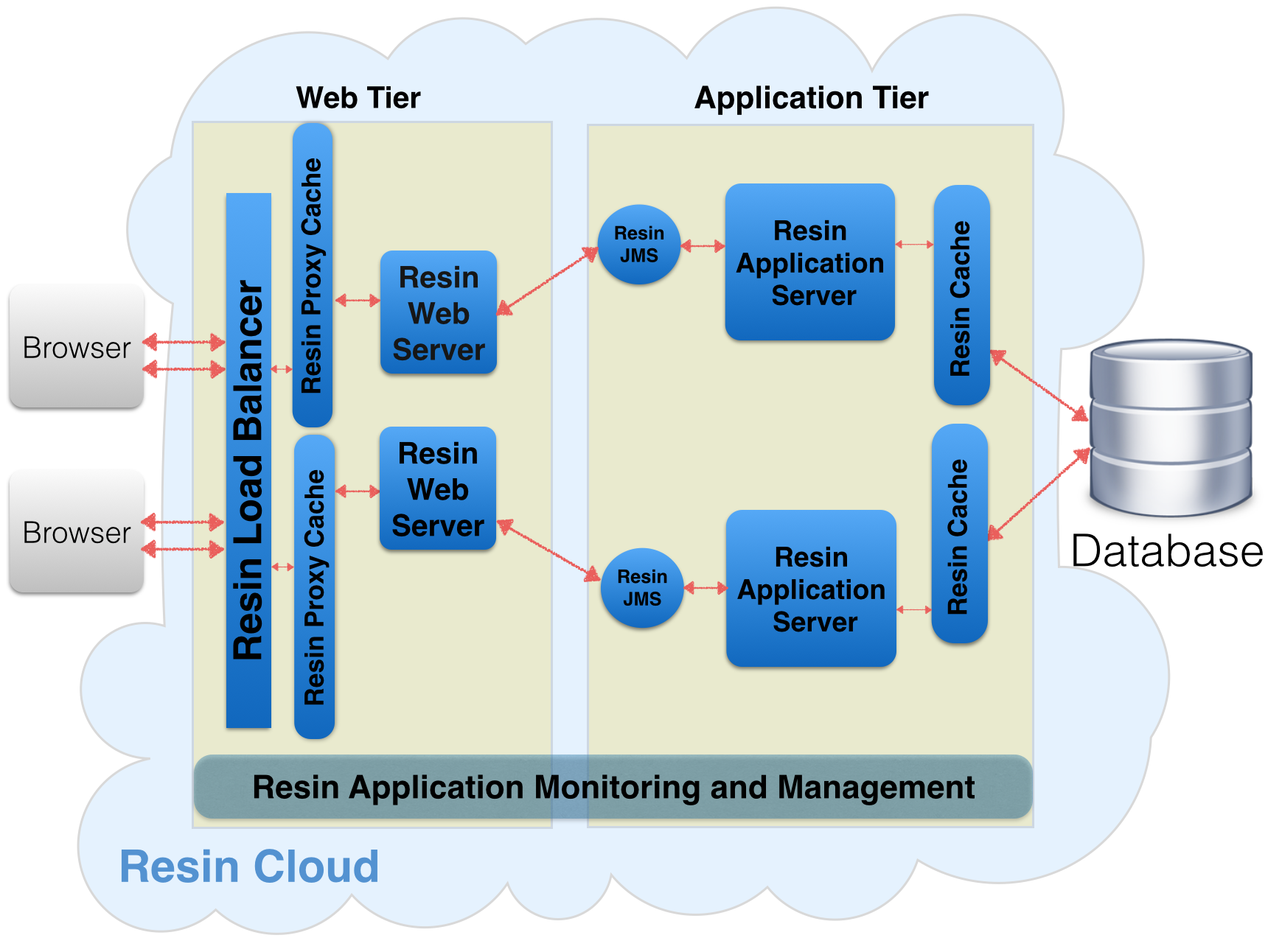Resin’s Java EE certified architecture is cloud-enabling. You can choose to have Resin power your SaaS application or utilize it as the backbone of your PaaS/IaaS platform. Resin’s lightweight and modular base allows you to position your application in a public, private or hybrid cloud.
The Resin Stack
The entire Resin product line’s incredible growth is driven by fast performance, built-in server monitoring capabilities and extreme reliability. Resin’s unsurpassed reliability is a testament of its Health System and Watchdog process. Resin’s Health System provides server monitoring and JVM monitoring and full server recoverability (self healing).
   |
Resin Smart Load BalancerAs traffic increases beyond a single server, Resin’s load-balancing lets you add new machines to handle the load and simultaneously improves uptime and reliability by failing over requests from a downed or maintenance server to a backup transparently. <resin:LoadBalance> is part of Resin’s rewrite capabilities, Resin’s equivalent of the Apache mod_rewrite module, providing powerful and detailed URL matching and decoding. More sophisticated sites might load-balance based on the virtual host or URL using multiple tags. Documenation: Smart Load Balancing Once your traffic increases beyond the capacity of a single application server, your site needs to add a HTTP load balancer as well as the second application server. Your system is now a two tier system: an app-tier with your program and a web-tier for HTTP load-balancing and HTTP proxy caching. Since the load-balancing web-tier is focusing on HTTP and proxy caching, you can usually handle many app-tier servers with a single web-tier load balancer. Although the largest sites will pay for an expensive hardware load balancer, medium and small sites can use Resin’s built-in load-balancer as a cost-effective and efficient way to scale a moderate number of servers, while gaining the performance advantage of Resin’s HTTP proxy caching. |
 |
Resin HTTP Proxy CacheServer caching can speed dynamic pages to near-static speeds. When pages created by database queries only change every 15 minutes, e.g. CNN or Wikipedia or Slashdot, Resin can cache the results and serve them like static pages. Because Resin’s caching only depends on HTTP headers, it will work for any JSPs, servlet or PHP page.response. Resin’s caching operates like a proxy cache, looking at HTTP headers to compare hash codes or digests or simply caching for a static amount of time. Since the proxy cache follows the HTTP standards, applications like Mediawiki will automatically see dramatic performance improvement with no extra work. You can even cache REST-style GET requests. Because the cache supports advanced headers like “Vary”, it can cache different versions of the page depending on the browser’s capabilities. Gzip-enabled browsers will get the cached compressed page while more primitive browsers will see the plan page. With “Vary: Cookie”, you can return a cached page for anonymous users, and still return a custom page for logged-in users. |
 |
Resin Web ServerBehind the scenes, Resin is powered by its own full web server developed 100% in-house at Caucho. Because we have full control and can optimize each individual component, Resin Web Server is able to serve static pages faster than nginx™! Resin Web Server includes the following:
|
 |
Resin Application ServerHighly interactive web applications for tablets and phones will dominate the web in the next generation. Caucho’s relentless quest for performance and reliability paved the way for Resin Java Application Server to be a leading open source web and application server. Our Java EE Web Profile implementation includes Servlet, JSP, JSTL, EJB Lite, CDI, JSF, JMS and others. Resin provides an ideal environment for lightweight web development – where you can deploy a fast and highly responsive site. Resin was the first Java EE Web Profile certified Java application server. Resin 4 is built from the ground up around Java Dependency Injection (CDI). Resin 4 is optimized to work in cloud computing environments like Amazon EC2.
With built-in support for both internal and external virtualized Documentation: Enterprise Clustering for Cloud Environments Short Video with Animations Describing Resin Cloud SupportThe Resin 4 core and configuration is built around the Java EE
|
 |
Resin Distributed CacheJava caching can speed application performance and lower database load by annotating cacheable methods. Resin application server that supports both CDI and JCache, you can add caching easily without much configuration. It uses the method parameters as a cache key, and stores the method result in the cache. On the next method call, the enhanced method will look for the saved result in the cache, and return it, saving the effort of the method. You’ll want to cache to:
Resin Cache features:
“Resin’s cache support is fast, durable and fully elastic, |
|
♡
|
Resin Adaptive Health MonitoringBecause your site’s reliability is important, Resin monitors its internal sensor net every 60 seconds, recording your server’s memory, cpu, network, database and cluster status. Resin monitors JVM metrics, Java Application Servers metrics and OS metrics. The Resin JAMM saves the data so you can adjust the servers based on load, and can analyze problems after they occur. The data is saved so Resin can identify trends and anomalies. Each 15 minutes, the health system checks the sensor data and reports a status: OK, WARNING, CRITICAL or FAIL. You can direct Resin’s health system to act based on the health check results, mailing a notification, gathering further thread and memory information or even restarting.
|
Get started today!
One install. One management. Everything you need. At Caucho, we pride ourself in having built virtually every component of Resin in-house to allow Resin to outperform all other solutions out there. Resin is all you need to build scalable data-intensive cloud applications.
It is difficult to scale your application when your underlying architecture is built upon many 3rd party packages. Each 3rd party component requires separate update schedules, memory, resources, and expensive licensing; it is a management nightmare. With Resin, you do not waste time with 3rd party components or external dependencies. When you scale Resin, you scale your entire application. You are not straddled with managing multiple components in a complex production environment. Your time is freed to develop and improve your application. The diagram below highlights the advantages of Resin’s uniform solution over multiple 3rd party packages:
Your all-in-one lightweight solution
Resin solves the aforementioned problems by providing the first architecture that is built in-house and intended for massively scalable and data-rich applications. Resin provides your application with:
- Components that are optimized to work together
- No external dependencies
- Ability to easily upgrade and test without rearchitecting
- Minimal memory footprint so your hardware costs stay low
- Support directly from engineers who work on Resin’s code
Resin’s core components provide you with everything needed to build and maintain robust enterprise applications. Resin also comes out of the box with plug-and-play support for the top industry standards in caching, health monitoring, and messaging so you are can easily integrate into your current environment.





